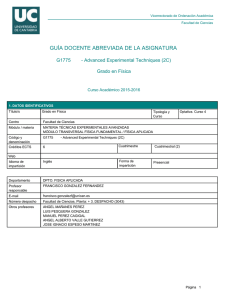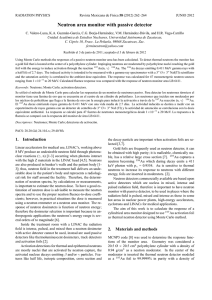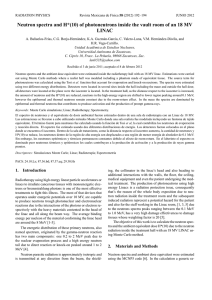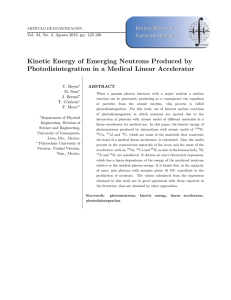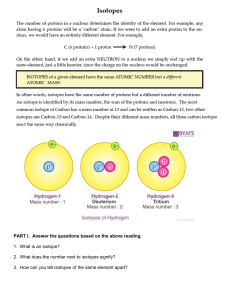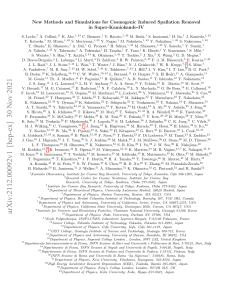Neutron room return effect
Anuncio
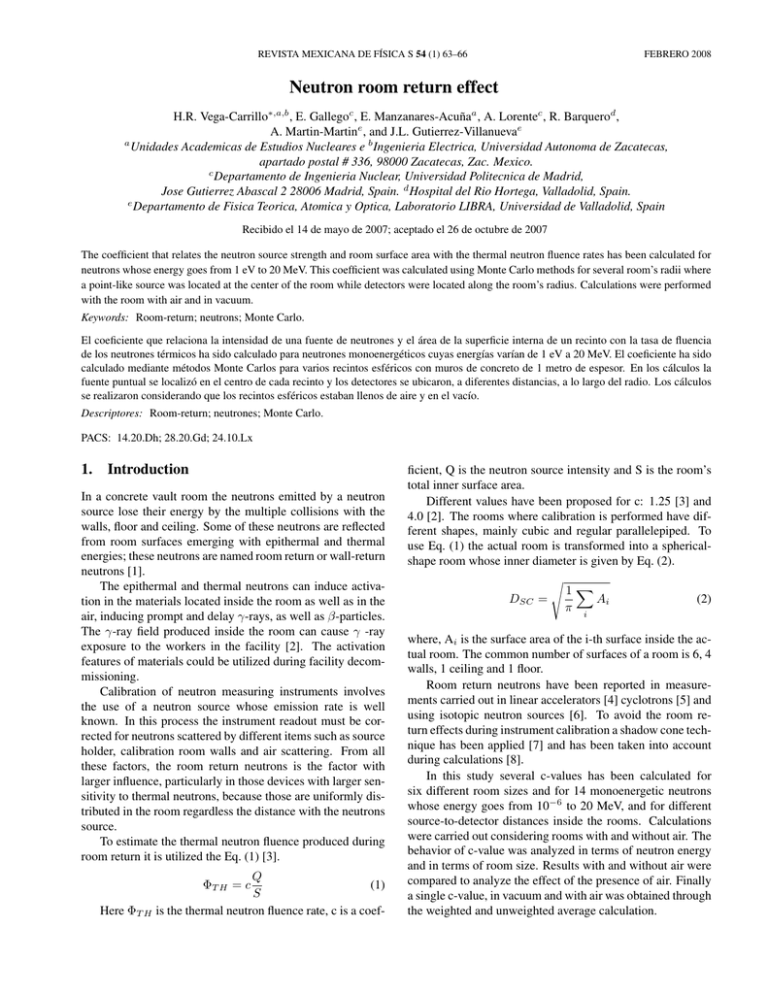
REVISTA MEXICANA DE FÍSICA S 54 (1) 63–66 FEBRERO 2008 Neutron room return effect H.R. Vega-Carrillo∗,a,b , E. Gallegoc , E. Manzanares-Acuñaa , A. Lorentec , R. Barquerod , A. Martin-Martine , and J.L. Gutierrez-Villanuevae a Unidades Academicas de Estudios Nucleares e b Ingenieria Electrica, Universidad Autonoma de Zacatecas, apartado postal # 336, 98000 Zacatecas, Zac. Mexico. c Departamento de Ingenieria Nuclear, Universidad Politecnica de Madrid, Jose Gutierrez Abascal 2 28006 Madrid, Spain. d Hospital del Rio Hortega, Valladolid, Spain. e Departamento de Fisica Teorica, Atomica y Optica, Laboratorio LIBRA, Universidad de Valladolid, Spain Recibido el 14 de mayo de 2007; aceptado el 26 de octubre de 2007 The coefficient that relates the neutron source strength and room surface area with the thermal neutron fluence rates has been calculated for neutrons whose energy goes from 1 eV to 20 MeV. This coefficient was calculated using Monte Carlo methods for several room’s radii where a point-like source was located at the center of the room while detectors were located along the room’s radius. Calculations were performed with the room with air and in vacuum. Keywords: Room-return; neutrons; Monte Carlo. El coeficiente que relaciona la intensidad de una fuente de neutrones y el área de la superficie interna de un recinto con la tasa de fluencia de los neutrones térmicos ha sido calculado para neutrones monoenergéticos cuyas energı́as varı́an de 1 eV a 20 MeV. El coeficiente ha sido calculado mediante métodos Monte Carlos para varios recintos esféricos con muros de concreto de 1 metro de espesor. En los cálculos la fuente puntual se localizó en el centro de cada recinto y los detectores se ubicaron, a diferentes distancias, a lo largo del radio. Los cálculos se realizaron considerando que los recintos esféricos estaban llenos de aire y en el vacı́o. Descriptores: Room-return; neutrones; Monte Carlo. PACS: 14.20.Dh; 28.20.Gd; 24.10.Lx 1. Introduction In a concrete vault room the neutrons emitted by a neutron source lose their energy by the multiple collisions with the walls, floor and ceiling. Some of these neutrons are reflected from room surfaces emerging with epithermal and thermal energies; these neutrons are named room return or wall-return neutrons [1]. The epithermal and thermal neutrons can induce activation in the materials located inside the room as well as in the air, inducing prompt and delay γ-rays, as well as β-particles. The γ-ray field produced inside the room can cause γ -ray exposure to the workers in the facility [2]. The activation features of materials could be utilized during facility decommissioning. Calibration of neutron measuring instruments involves the use of a neutron source whose emission rate is well known. In this process the instrument readout must be corrected for neutrons scattered by different items such as source holder, calibration room walls and air scattering. From all these factors, the room return neutrons is the factor with larger influence, particularly in those devices with larger sensitivity to thermal neutrons, because those are uniformly distributed in the room regardless the distance with the neutrons source. To estimate the thermal neutron fluence produced during room return it is utilized the Eq. (1) [3]. Q (1) S is the thermal neutron fluence rate, c is a coefΦT H = c Here ΦT H ficient, Q is the neutron source intensity and S is the room’s total inner surface area. Different values have been proposed for c: 1.25 [3] and 4.0 [2]. The rooms where calibration is performed have different shapes, mainly cubic and regular parallelepiped. To use Eq. (1) the actual room is transformed into a sphericalshape room whose inner diameter is given by Eq. (2). s 1X DSC = Ai (2) π i where, Ai is the surface area of the i-th surface inside the actual room. The common number of surfaces of a room is 6, 4 walls, 1 ceiling and 1 floor. Room return neutrons have been reported in measurements carried out in linear accelerators [4] cyclotrons [5] and using isotopic neutron sources [6]. To avoid the room return effects during instrument calibration a shadow cone technique has been applied [7] and has been taken into account during calculations [8]. In this study several c-values has been calculated for six different room sizes and for 14 monoenergetic neutrons whose energy goes from 10−6 to 20 MeV, and for different source-to-detector distances inside the rooms. Calculations were carried out considering rooms with and without air. The behavior of c-value was analyzed in terms of neutron energy and in terms of room size. Results with and without air were compared to analyze the effect of the presence of air. Finally a single c-value, in vacuum and with air was obtained through the weighted and unweighted average calculation. 64 H.R. VEGA-CARRILLO et al. 2. Materials and methods Using the MCNP 4C code [9] a 100 cm-thick concrete spherical shell room was modeled. In the model a point-like neutron source was located at the center of the concrete spherical shell where detectors were located at different distances from the source until approximately 10 cm before the shell inner surface. The amount of histories utilized during Monte Carlo calculation was large enough to reach a statistical error less than 1%. Six different spherical rooms, with 1 meter-wall thickness, were utilized, whose inner radii were 150, 200, 300, 535, 832 and 1010 cm; that represent rooms whose inner area surfaces are: 28.3, 50.3, 113.1, 360, 870, 1282 m2 . These dimensions represent mostly all actual calibration-room sizes. Starting from the neutron source neutrons were isotropically transported throughout the room, whose inner radius is RSC , and the neutron spectrum was obtained; from this the thermal neutron fluence was obtained at different source-todetector distances (SDD). For each detector, the respective c-value was calculated using, c= 4π 2 R ΦT H Q RC (3) For each room, an average c-value was calculated and has been defined in terms on neutron energy. Finally, a single c-value was calculated by obtaining the average of all the cvalues regardless room size and neutron energy. 3. Results and discussion In Figs. 1 and 2 it is shown the neutron spectra at a SDD of 100 cm, for 0.5 and 20 MeV monoenergetic neutron sources, F IGURE 1. Neutron spectrum at 100 cm obtained inside a 150 cmradius room in vacuum produced by two monoenergetic neutrons. F IGURE 2. Neutron spectrum at 100 cm obtained inside a 300 cm-radius room in vacuum produced by two monoenergetic neutrons. inside two rooms without air, 150 and 300 cm-radii respectively. Here, can be noticed that even when the neutron source was monoenergetic the room return effect produces epithermal and thermal neutrons. Being this last approximately constant regardless the neutron energy and room size. As the room size increases the thermal neutron fluence is larger in comparison with the epithermal neutrons. In Figs. 3 and 4 the thermal neutron fluence rate produced by monoenergetic neutrons inside a 150 and 1010 cm-radius spherical cavity, in vacuum, are shown. In both figures it can be noticed that for each neutron source energy value, the thermal neutron fluence rate is approximately constant for any source-to-detector distance. This behavior appears to increase in the vicinity of the inner room surface. This is in agreement to results published in literature [2,3,10,11]. F IGURE 3. Thermal neutron fluence rate produced by monoenergetic neutrons in terms of source-to detector distance inside a 150 cm-radius room in vacuum. Rev. Mex. Fı́s. S 54 (1) (2008) 63–66 STUDY OF NEUTRON ROOM RETURN EFFECT The c-values in terms of neutron energy for rooms in vacuum are shown in Fig. 5, while in Fig. 6 the c-values are shown in rooms with air. In both figures bar errors are smaller than symbols, i.e. less than 1 %. For rooms with and without air coefficients tend to be larger as the radius of spherical cavity increases. Comparing the c-values in rooms without air with those reported in literature [2] the shape of average coefficient in terms of neutron energy is similar. However, our c-values are smaller in 9 to 14%, this difference is probably due to the different cross section libraries used. The presence of air appears to reduce the c-value, particularly for larger rooms and for low energy neutrons. Also it can be noticed that the c-value is approximately the same for neutrons whose energy is larger than 1.0 MeV. The mean c-value calculated using all the c-values obtained for all source-to-detector distances, spherical cavity sizes in vacuum, and neutron energies is 4.0 ± 0.2 for unweighted average, and 5.6 ± 0.1 for weighted average. The first value is the same as that reported by Ishikawa et al. [2], where they also did use Monte Carlo methods, although they F IGURE 6. Average c-value in terms of neutron energy for rooms with air. did the calculations for few rooms and for neutrons up to 400 MeV. The second average is equal to the value reported by Eisenhauer et al. [10] however their value was experimentally obtained and using two neutron sources. For rooms with air the unweighted average c-value is 3.6 ± 0.1, while 4.8 ± 0.4 is the weighted average. Both cases, with air or in vacuum the mean c-values are quite different of 1.25 recommended by Patterson and Thomas [3]. 4. F IGURE 4. Thermal neutron fluence rate produced by monoenergetic neutrons in terms of source-to detector distance inside a 1010 cm-radius room in vacuum. 65 Conclusions A Monte Carlo study has been carried out to estimate the thermal neutron fluence rate produced by those neutrons produced by the neutron source that after suffer collisions in the room concrete surfaces and are returned back to the room as thermal neutrons: the room return neutrons. The room-return neutrons are practically independent of source-to-detector distance and it slightly varies with the room size. On the other hand, c-values slightly change with the room dimensions while a strong variation is noticed with neutron source energy. Whenever is feasible it is recommended to use the cvalues in terms of neutron energy for rooms with air. If this is not possible and Eq. (1) it is used to estimate the thermal neutron fluences rate the recommended c-value is 5.6 ± 0.1 for small rooms facilities (RSC < 200 cm) where the presence of air is not relevant. For larger rooms (RSC > 200 cm) it is recommended to use 4.8 ± 0.4. Those values are closer to those recommended in literature [2,10]. Acknowledgments F IGURE 5. Average c-value in terms of neutron energy for rooms in vacuum. This work is part of SYNAPSIS research project partially supported by CONACyT (Mexico) under contract SEP-2004C01-46893. Rev. Mex. Fı́s. S 54 (1) (2008) 63–66 66 H.R. VEGA-CARRILLO et al. ∗. Correspondig author, e-mail: fermineutron@yahoo.com. 1. R. McCall, Med. Phys 26 (1999) 206. 2. T. Ishikawa, H. Sugita, and T. Nakamura, Health Physics 60 (1991) 209. 3. H.W. Patterson and R.H. Thomas, Accelerator Health Physics, Academic Press (New York, 1973). 4. P.H. McGinley and J.C. Landry, Physics in Medicine and Biology 34 (1989) 777. 5. N.E. Hertel et al., Radiation Protection Dosimetry 108 (2004) 255. 6. E. Gallego, A. Lorente, and H.R. Vega-Carrillo, Radiation Protection Dosimetry 110 (2004) 73. 7. A.M. Williams, P.A. Beeley, and N.M. Spyrou, Radiation Protection Dosimetry 110 (2004) 497. 8. Uwamino et al., Radiation Protection Dosimetry 115 (2005) 279. 9. J.F. Briestmeister, editor, MCNPT M -A general Monte Carlo Nparticle transport code, Los Alamos National Laboratory Report LA-13709-M (2000). 10. C.M. Eisenhauer, R.B. Schwartz, and T. Johnson, Health Physics 42 (1982) 489. 11. C.M. Eisenhauer, Radiation Protection Dosimetry 28 (1989) 253. Rev. Mex. Fı́s. S 54 (1) (2008) 63–66
